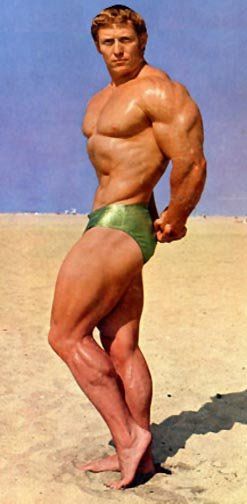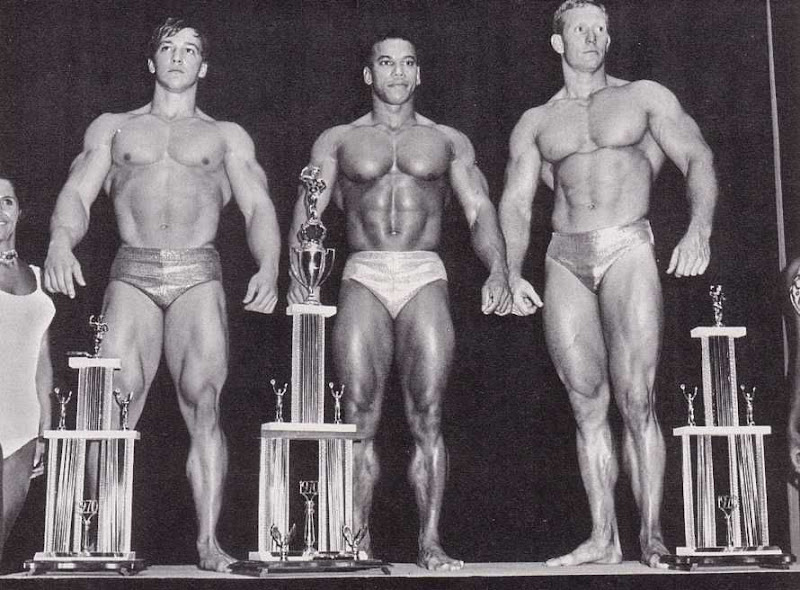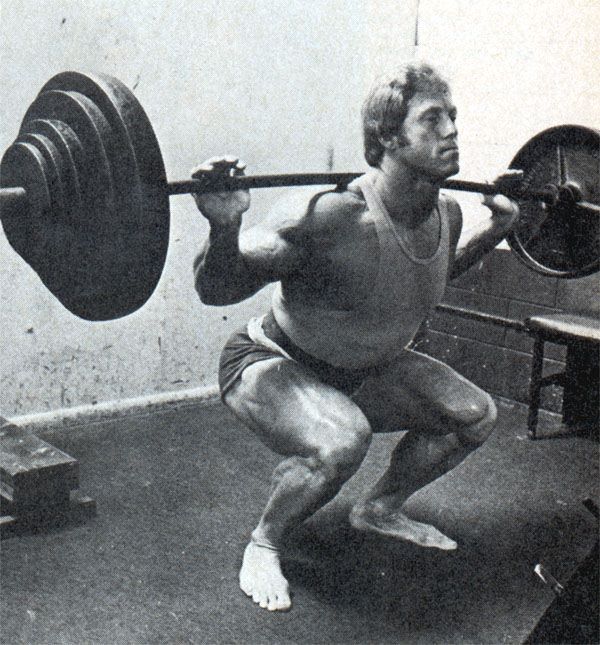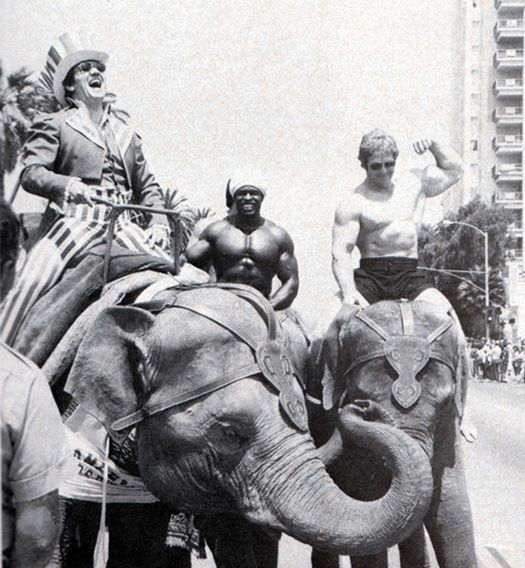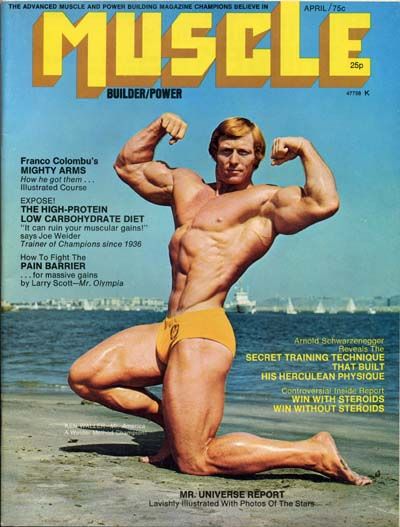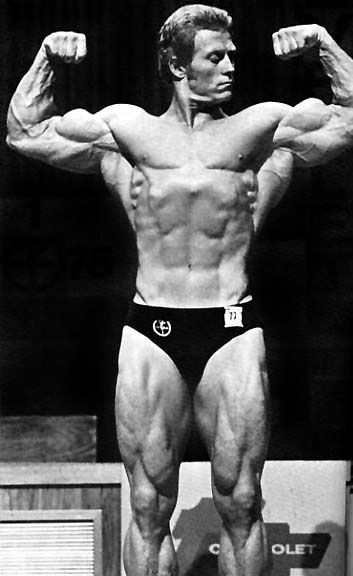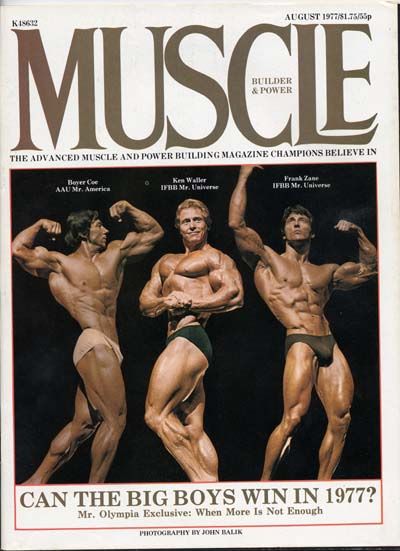This blog is an excellent resource on bodybuilding, both for old pros and those just starting out. Check back regularly for articles, workouts you can use.
Mar 17, 2009
Legendary leg training program of Ken Waller

Ken Waller was one of the leading body-in 70-is. Perhaps you saw him in "Pumping Iron", where he served as the main rival of Arnold Schwarzenegger. I first met him when he participated in the IFBB "Mr. America" in 1971. It was unanimously recognized as a winner and, as usual, received the award "Best Legs", but it was only the beginning of his stellar career.
In 1975 Waller fix their eyes on winning the contest IFBB "Mr. Universe", which was held in Pretoria, South Africa. His main competitors were Mike Katz , Paul Grant and the sensational newcomer Robbie Robinson. Robinson, Grant and Waller are trained in the Gold's in Venice, as well as Arnold Schwarzenegger, Franco Columbu and Frank Zane. The fight was so hot and intense that it became the subject of a bet. Waller argue with anyone who came to $ 100 per person, that he will win all, and launched one of the greatest scam in the history of sports transactions. He began appearing in the gym in baggy clothes, forcing him to look more thick. He made several approaches, and then began to complain that he feels it does not matter in order to train and care. And 18 does not believe in his victory simpletons set against it. I put $ 100 on Robbie Robinson.
But the fact that we did not know was that Waller trained like mad at Mickey's Gym near Redondo Beach. He has an inflated like a bear at the "Mr. Universe" and won them all. He also collected $ 1800 in cash with them deceived simpletons. It certainly taught me a lesson - never as not make a bet with Ken Waller.
Although he has a very symmetrical physique, but most of all Waller was known for his feet, producing a sensation. Here, in his words, those methods that he used while developing them.
Many guys have big hips - some even too big. Never had a certain level of the hips, which sought to body-as, for example, for the purpose of them is 20 - inch arm. Nevertheless, there is an obstacle to the development of excellent, and this aesthetic. You must be able to combine the mass, shape and topography - and exercises to develop all these qualities operate against one another. The mass obtained by squatting, nullifying the elegant shape and topography. Shape resulting from the implementation of specific exercises, requires a great deal of work and lots of repetition, which leads to a reduction in size. Clarity relief lines, which is also achieved through the repeated performance of specific exercises, requires adherence to a diet that further reduces weight. The aim is to achieve a balance between these three factors.
The most important thing I discovered for myself - is that work on the hips should be at the beginning of training, when your enthusiasm and energy are at its highest point. Work hard on the feet. I use a separate program, under which I practice deltoids, lateral muscle, chest and hands on Monday, Wednesday and Friday, and the strain on the calf, thigh and abdominal muscles give on Tuesday, Thursday and Saturday.
Here's the program.
Bob with a heavy pole. This is best for growth.
Place the bar higher on the shoulders, at the base of the neck, and in performing the exercises keep the back straight. I look at one point directly in front of himself to keep his head elevated, and his back straightened. I do squatting barefoot, standing with their feet on the floor. In this way, I achieve a good balance and arm and thigh work harder if I'm not putting the foot under the heel. Try it without the stand, but if you believe that the stand increases, then use it. I did not fall below the parallel position of the hips, because then the buttocks muscles are more likely than the hips. I mash with light weights by 12 repetitions. In the second approach, I add weight and do 10 repetitions, then I do the third approach, with the addition of weights and 8 repetitions, the fourth approach - more weight, and 6 repetitions, and the final approach - the heaviest weight, which I can only raise a 5 repetition. My best result - it is five times with 575 pounds. Heavy the press lying with his feet. This exercise increases the amount of external parts of the thighs (vastus lateralis). It also contributes to the middle of the thighs. In order to flex the first approach is easier to do with the weights, as well as drill heavy thighs and knees from another angle. I stepped up overburdened sequentially, with each approach, consisting of 12 repetitions, just do the five approaches. My limit - it is 1000 pounds in 12 recurrence, so you see that need more weights.
Bending of the legs lying on the simulator.
This develops the biceps thighs, and your legs look longer. I try to keep the upper body motionless, moving only their feet. Perform the movement until the complete reduction of the top and full bottom stretcher. Do five approaches 12 with a recurrence of the most heavy weights, allowing you to adhere strictly to the technique exercises.
Straightening of the legs on the simulator.
This improves the shape and drawing quadriceps. This is a good closing activity, because you can work on the hips until you stop of effort, without loading the lower back and does not require large amounts of oxygen. Do five approaches to 15 repetitions with maximum weights. Hold each repetition of the top point of the hips and stretch your muscles to the maximum reduction, before returning to its original position.
If you're primarily interested in building new muscle mass, use it only twice a week. If you're ready for competition, or photography, trains the legs three times a week. During the past six weeks in advance of the event follow another fifth exercise, Gakk-squatting, in order to achieve the best clarity of shape and form.
You should give yourself a minimum amount of time to rest between the approaches and exercises. When squatting, and press I never rest more than a minute. From 30 to 45 seconds - this is the maximum allowable time for other activities. You want to stimulate more growth, develop your thighs tight and fast.
Here is a complete program.
Do not forget all the exercises to perform with such high weights, which you just can.
Ken Waller program to improve the shape, length and elevation
Squatting on the bar 5 x 12, 10, 8, 6, 5
Press lying feet 5 x 12
Bending of the legs 5 x 12
Straightening legs 5 x 15
The above program is too difficult for less experienced body
- Here is a good option for them.
Intermediate Program
Squatting 5 x 12, 10, 8, 6, 5
Press lying feet 3 x 12
Bending legs 4 x 12
Here is another program that is very well suited for people with meager legs, poorly responsive to training.
Builder thighs
Bob 8 x 12
Bending of the legs 5 x 15
* With each subsequent approach Boost overburdened.
If your biceps can not be exposed to the feet, put them in first place in the training. Implementation of bending the legs in front squatting allows boost growth biceps thighs.
These programs provide a full load on the muscles of the hips, increasing the size and improving the form and striation thighs.
Mar 2, 2009
Dan Duchaine, Steroid Nation and Anthony Roberts

Overestimating the impact that Dan Duchaine had on the world of steroids would be impossible. It's easy to say that "steroid gurus" are a dime a dozen in the internet age, but I would disagree. There are no steroid gurus, there was only (and will only) ever be one.
I say this in retrospect, with almost a decade having transpired since his passing, and nobody having stepped up to the plate and been either as successful or as influential in the world of anabolic steroids. Truthfully, there would likely be no steroid gurus today if it weren't for Dan Duchaine, who introduced the steroid world to Bruce Kneller, Patrick Arnold, Bill Roberts, and a slew of others who owe their professional lives to him.
Posthumously these people referred to Dan as a colleague, but this is a complete fabrication; the truth is that while he was alive, he was unparalleled. Well, it may not be a complete fabrication, but it is a pretty good example of revisionist history. None of the people who, after Dan's death, have attempted to portray the situation as if they were on equal footing (or even close friends with him), are telling anything resembling the truth.
Bruce Kneller was never referred to as much more than a research assistant by Duchaine in anything I'd ever read by him, and Bruce actually attacked Dan quite extensively while he was alive (Calling him "a demented elf, feeding anti-freeze to the reindeer"…which is a colorful, yet admittedly bizarre thing to say about someone you'd later claim to be a friend. Yet after Dan passed away, the story Bruce tells of Dan makes it seem like they were friends and colleagues. I have a contextual problem with this.
Duchaine's writing told of his time in prison, his fondness for pale-skinned red-headed women, and many other personal factoids of his life. Nowhere did it mention that Bruce was such a close friend, or something more than an assistant - nowhere did Dan's writings of Bruce even come close to achieving the level of parity that Bruce's public (and post-facto) recollection of their relationship did (many years later). Although I didn't know Dan, I tend to travel in the circles he once did, and this is the way it seems to me.
Frankly, BALCO chemist Patrick Arnold, and many others (Bill Roberts, et al.) who claim that Dan was a friend and colleague, are in the same boat. Dan had been established in the industry for over a decade before any of them appeared on the scene (ushered in by Duchaine himself), and it is doubtful that anything resembling equality existed in their relationships with Dan. Yet, after Dan died, they all spoke of him as if they were as highly regarded by him as vice-versa. Truthfully, most of Dan's writings about these people are luke-warm at best - and not amazingly, all of them claimed that all of the others were inflating their relationship with Dan. This isn't meant to slam any of these guys (I've got nothing against any of them), it's just a statement of fact.
Dan was the biggest name in the industry, and they were up-and-coming. Once Dan died, they all portrayed themselves as his accepted equal; although none had attempted this feat while he was alive.
Quite literally, there would be no Anthony Roberts without Dan Duchaine either.
I first began reading Dan Duchaine when I picked up an issue of Muscle Media 2000. I can't remember what magazines I had read before that, because none of them ever seemed as important afterwards. None of them seem as important today either.
People who grew up in the '60s and smoked pot will always talk about how this album or that album changed their life (usually the Beatles White Album, or something by Led Zepplin). If you grew up in the '80s or '90s and used steroids, Dan Duchaine invariably had this kind of effect on you.
MM2K was a magazine of mostly decent writers (little w), and one exceptionally talented Writer (capitol W). I didn't read entire issues of any magazines back when I was sixteen, but I can tell you, almost verbatim, about every column that Dan ever wrote, because I read them over and over until the next issue came out.
I was sixteen years old, walking home from a bus stop in Hackensack, New Jersey when I passed a 7-11 that sold magazines. I had walked in to buy a locally produced (and now defunct) magazine about the New Jersey punk rock scene, but instead I picked up an issue of Muscle Media 2000.
I can trace my entire career back to that exact moment.
At that time, MM2K was in the process of evolving from a bi-monthly magazine into a monthly magazine, and the wait between issues was unbearable. What was Dan going to say next? By reading Dan Duchaine, I learned how to convert Finaplex Pellets into an injectable, how to make GHB at home, and that Denise Rutkowski moved her ass like a stripper during her posing routine. I saw him expose people in the bodybuilding industry in a way that could only be described as fearlessly honest; I learned that the only thing as important as your number of fans is the number of people who you piss off.
Dan Duchaine was the Sex Pistols of the steroid world.
And just like the Sex Pistols, he spawned an entire new way of thinking about things. His contribution wasn't necessarily important in an artistic sense or a technical sense, as much as it was important in a cultural sense. Dan made it alright to admit to using steroids - he made it cool to talk about them in a scientific sense, but without losing the practical side.
Dan not only had his popular "Ask the Guru" column in Muscle Media 2000, but soon he also began writing another column, called "Rant" that dealt with whatever he felt like talking about. Shortly after "Rant" appeared in MM2K, "Rage" ("Romano's Rage Page") appeared in Muscular Development (in a more alliterative, though highly inaccurate analogy, I'd be able to say that Romano = The Ramones).
Before Dan Duchaine I can't remember a single article in any bodybuilding magazines that really stuck out in my mind. I remember dozens of articles that told me How to Build:
* Cannonball Delts
* Melon-sized Delts
* Washboard Abs
* Tree Trunk Legs
And even how to "Turn your Calves into Cows!" (Which is pretty much what the bodybuilding rags still talk about). At that point, nothing was ever more real or exciting than reading Dan Duchaine tell the world that he did not, in fact, care who won the Mr. Olympia (while all the other magazines at the time were fawning over the latest-greatest champ)
I remember home-brewing a mixture of Yohimbe powder and DMSO into a topical fat-loss product after Dan wrote out the recipe in an article; now, there are several brands of this type on the market…all earning money from an idea Dan had given away for free, over a decade ago. I can name several "innovative" nutritional products currently on the market, designed by alleged "steroid experts" and point to exactly the date that Dan Duchaine first introduced the idea to the steroid world, usually a decade before the product hit the mainstream supplement market. Everyone who has ever seriously researched anabolic steroids, and is involved in the nutritional supplement market has read Dan's work, and borrowed extensively from it; with 3 steroid books and 5 nutritional supplements that I've had a hand in creating, I'll be the first to tell you that I'm no exception to that rule.
Dan once wrote an article about what supplements he would use if he only had $100/month to spend - his recommendations can be found on my monthly supplement bill to this day, each month.
His writing had a fire and skill that nobody in the bodybuilding world has ever come close to matching. I had thought this back in the mid '90s when I started reading Dan's work, and I think it now. When Dan's writing really caught on, he forced change within the bodybuilding industry. People had to take the issue of drug use - and more importantly - drug information seriously. As Dan's popularity grew to titanic proportions, magazines began more regularly running their own steroid articles and began hiring (manufacturing) their own in-house experts on steroids.
But nobody was Dan Duchaine; he viciously attacked the medical community for their shortcomings in practical application of anabolic steroid therapy, taking no prisoners. Now, it seems like everyone has taken up that fight, but don't be fooled - Dan was the first. He did it when it was edgy and dangerous to be doing what he did, not when everybody else was doing it.
Dan was interested in bikes and speakers, and had a ton of hobbies - but bodybuilding wasn't one of them. He ran the risk of ostracizing himself from his core audience by admitting this, but did so anyway. He said that it didn't matter if he was big, because he had a big brain - and later dismissed the idea of him being a genius by telling everyone that IQ tests simply rewarded white guys who have a good memory with a high score. That was one of the most amazing things I'd ever read in an interview, until that point.
Even today, Steroid Nation, a relatively-poorly written book about steroids produced by ESPN books, reads like a Dan Duchaine biography. I say it's poorly written, but the truth is that it is the best effort someone who is so far outside of the steroid using community can accomplish - and of course, because it is in fact an unexciting book about an exciting subject. I should at this point note that the author of Steroid Nation has written a couple of other books, one about NASCAR and one about Professional Wrestling, and in both cases people who really know the subculture for these respective these industries have found the books boring and a bit fake. Nonetheless, I think that it would be impossible for one person to legitimately be an expert about NASCAR, Steroids, and Professional Wrestling.
Most importantly, I don't think Dan would have liked Steroid Nation. Dan would have laughed at the idea of somebody who doesn't use steroids writing about them…or at least I reserve the right to make that supposition.
Conversely I labor under the entirely self-important presupposition that a.) he would have liked my books, and b.) that people who have spoken to the two of us have said that we "share some similarities". Of course, out of those two statements, one is entirely fabricated by me (a), and the other is conjecture by other people (b).
In 1999 when I was almost out of college, Testosterone Nation (or whatever they are calling themselves now-a-days) interviewed Dan Duchaine, and I read that interview an embarrassing amount of times (one of my roommates had the "internet"). In 2006, they interviewed me, heralding me as the new Duchaine.
The truth is that there will never be another Dan.

The Real Dan Duchaine? by Shelley Hominuk
anthony robertsAnthony Roberts is the author of three published books on anabolic steroids, and the forthcoming book "Generation S". He has written numerous articles on that topic, as well as having had training, nutrition, and supplementation articles published by a variety of print and online outlets. Additionally he has worked as a supplement designer, specializing in sports supplements. As a trainer and consultant he has helped athletes at all levels of competition, including Professional Bodybuilders, Rugby Teams, MMA competitors, Powerlifters, and even figure competitors.
Subscribe to:
Posts (Atom)
